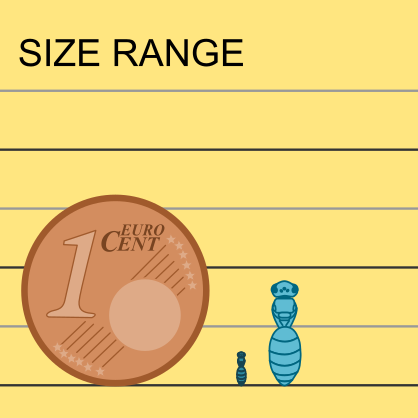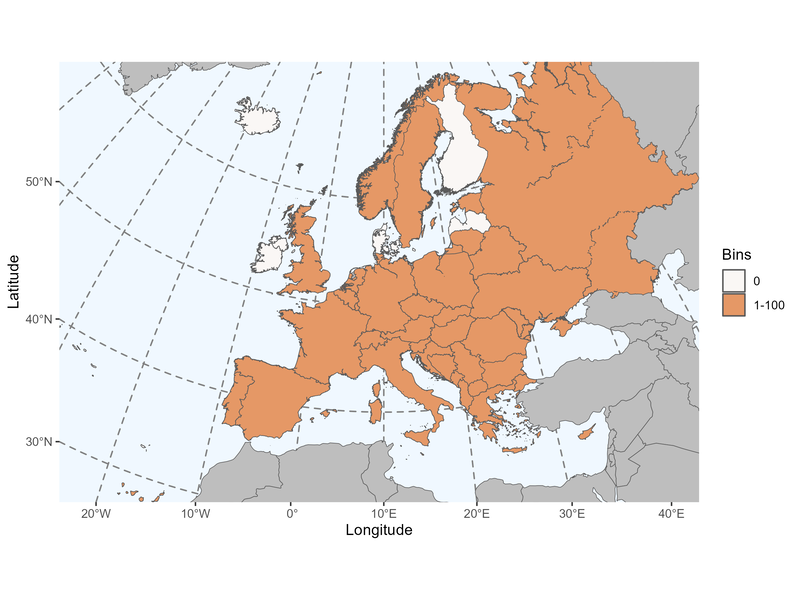Author: Latreille, 1803
|
Type species: Hylaeus albilabris, 1793 = Apis cucurbitina Rossi, 1792, Monobasic, Placed on official List of Generic Names in Zoology by Commission Opinion 1011 (1973).
Subgenera: Ceratina s.str. Latreille, 1802; Euceratina Hirashima, Moure and Daly, 1971; Neoceratina Perkins, 1912; Pithitis Klug, 1807. Synonyms: Clavicera Latreille, 1802 |
Clade: Anthophila
Family: Apidae Subfamily: Xylocopinae Tribe: Ceratinini |
|
Distinctive traits
|
Pictures of distinctive traits.
(Sorry, there is no picture available at this time. If you have some and would like to become a contributor to IDmyBee, please contact us.) |
Morphologically close genera and how to distinguish them:
There are several small black bees that can be confused with Ceratina, however most of them have a 'short tongue' morphology, while Ceratina species have 'long tongue' ones. Some genera like 'Panurgus' may have long mouthparts, but the morphology remains that of a 'short-tongue' (short glossa and palpi with segment of similar size). In addition they have only two submarginal cells, and / or they lack the pygidial plate.
There are several small black bees that can be confused with Ceratina, however most of them have a 'short tongue' morphology, while Ceratina species have 'long tongue' ones. Some genera like 'Panurgus' may have long mouthparts, but the morphology remains that of a 'short-tongue' (short glossa and palpi with segment of similar size). In addition they have only two submarginal cells, and / or they lack the pygidial plate.
General comments on Ceratina species identification
Identification criteria of females include body size, colour, size of the pale spots on the face, density of punctation of the face and thorax, shape of the hypostomal carina.
Males can be distinguished using the shape of T7 and pilosity of the posterior leg.
Identification criteria of females include body size, colour, size of the pale spots on the face, density of punctation of the face and thorax, shape of the hypostomal carina.
Males can be distinguished using the shape of T7 and pilosity of the posterior leg.
Sorry, but the species identification tool is not yet available for Ceratina.
Please check the reference(s) at the bottom of the page for traditional keys.
Please check the reference(s) at the bottom of the page for traditional keys.
|
st of the 26 Ceratina species found in Europe (Ghisbain et al. 2023)
Ceratina (Ceratina) cucurbitina (Rossi, 1792) Ceratina (Dalyatina) parvula Smith 1854 Ceratina (Euceratina) acuta Friese, 1896 Ceratina (Euceratina) albosticta Cockerell, 1931 Ceratina (Euceratina) callosa (Fabricius, 1794) Ceratina (Euceratina) chalcites Germar, 1839 Ceratina (Euceratina) chalybea Chevrier, 1872 Ceratina (Euceratina) chrysomalla Gerstaecker, 1869 Ceratina (Euceratina) cyanea (Kirby, 1802) Ceratina (Euceratina) cypriaca Mavromoustakis, 1949 Ceratina (Euceratina) dallatorreana Friese, 1896 Ceratina (Euceratina) dentiventris Gerstaecker, 1869 Ceratina (Euceratina) gravidula Gerstaecker, 1869 |
Ceratina (Euceratina) loewi Gerstaecker, 1869 Ceratina (Euceratina) mandibularis Friese, 1896 Ceratina (Euceratina) mocsaryi Friese, 1896 Ceratina (Euceratina) moricei Friese, 1899 Ceratina (Euceratina) nigroaenea Gerstaecker, 1869 Ceratina (Euceratina) nigrolabiata Friese, 1896 Ceratina (Euceratina) sakagamii Terzo, 1998 Ceratina (Euceratina) saundersi Daly, 1983 Ceratina (Euceratina) teunisseni Terzo & Rasmont, 1997 Ceratina (Euceratina) zandeni Terzo, 1998 Ceratina (Neoceratina) bispinosa Handlirsch, 1889 Ceratina (Neoceratina) schwarzi Kocourek 1998 Ceratina (Pithitis) tarsata Morawitz, 1872 |
References with identification keys for some of the species:
- Amiet, F., Herrmann, M., Müller, A., & Neumeyer, R. (2007). Apidae 5: Ammobates, Ammobatoides, Anthophora, Biastes, Ceratina, Dasypoda, Epeoloides, Epeolus, Eucera, Macropis, Melecta, Melitta, Nomada, Pasites, Tetralonia, Thyreus, Xylocopa (Vol. 5). Centre suisse de cartographie de la faune.
- Terzo, M., Iserbyt, S., & Rasmont, P. (2007). Révision des Xylocopinae (Hymenoptera: Apidae) de France et de Belgique. In Annales de la Société Entomologique de France 43(4) : 445-491.
- Falk S.J. (2015) Field Guide to the Bees of Great Britain and Ireland. Bloomsbury wildlife guides. 432 p.
Online resources:
Atlas hymenoptera (Europe, France & Belgium)
BWARS (UK)
Discover Life (World)
WestPalBees (West Palearctic)
Atlas hymenoptera (Europe, France & Belgium)
BWARS (UK)
Discover Life (World)
WestPalBees (West Palearctic)
Page contributors:
You noticed a mistake? You have a suggestion to improve this page?
Don't keep it to yourself, contact us and become a contributor to IDmyBee!
- Adrien Perrard (Dec. 2023)
- Adrien Perrard (Dec. 2019)
You noticed a mistake? You have a suggestion to improve this page?
Don't keep it to yourself, contact us and become a contributor to IDmyBee!
References used to write this page:
- Ghisbain, G., Rosa, P., Bogusch, P., Flaminio, S., Le Divelec, R., Dorchin, A., Kasparek, M., Kuhlmann, M., Litman, J., Mignot, M., Müller, A., Praz, C., Radchenko, V.G., Rasmont, P., Risch, S., Roberts, S.P.M., Smit, J., Wood, T.J., Michez, D. & Reverte, S. (2023). The new annotated checklist of the wild bees of Europe (Hymenoptera: Anthophila). Zootaxa, 5327(1), 1-147.
- Michener, C.D. 2007. The Bees of the World, 2nd Edition. The John Hopkins University Press, Baltimore.
- Michez D., Rasmont P., Terzo, M., Vereecken, N. 2019. Abeilles d'Europes. Hymenoptères d'Europes, Volume 1. N.A.P. Editions.
- Nieto, A., Roberts, S. P., Kemp, J., Rasmont, P., Kuhlmann, M., García Criado, M., ... & Michez, D. 2014. European red list of bees. Luxembourg: Publication Office of the European Union, 98.
- Rasmont, P., Devalez, Jelle, Pauly, A., Michez, D. & Radchenko, V.G. 2017. Addition to the checklist of IUCN European wild bees (Hymenoptera: Apoidea). Annales de la Société entomologique de France 53: 17-32.



